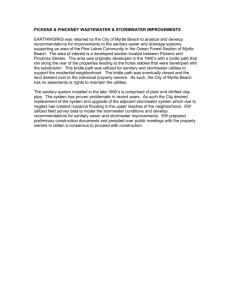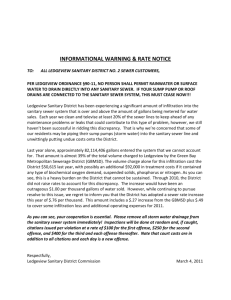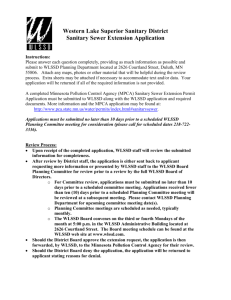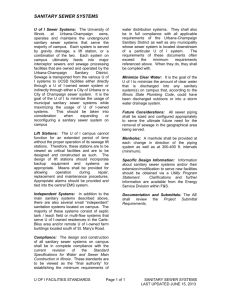Source Control Measures Guidance and Model List
advertisement
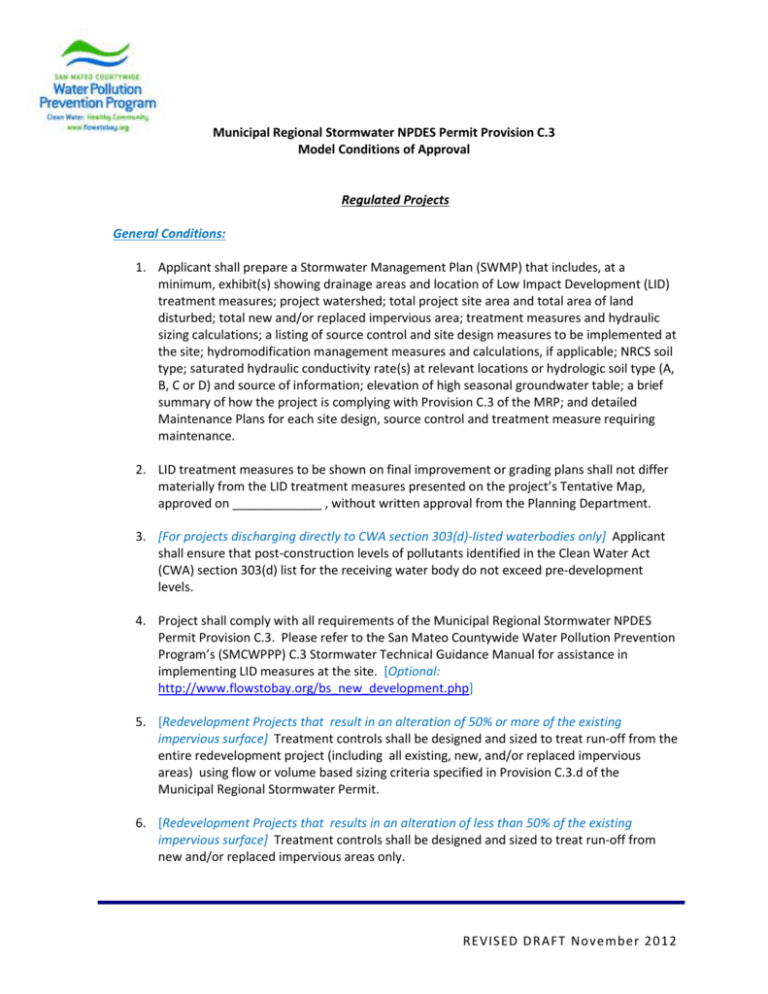
Municipal Regional Stormwater NPDES Permit Provision C.3 Model Conditions of Approval Regulated Projects General Conditions: 1. Applicant shall prepare a Stormwater Management Plan (SWMP) that includes, at a minimum, exhibit(s) showing drainage areas and location of Low Impact Development (LID) treatment measures; project watershed; total project site area and total area of land disturbed; total new and/or replaced impervious area; treatment measures and hydraulic sizing calculations; a listing of source control and site design measures to be implemented at the site; hydromodification management measures and calculations, if applicable; NRCS soil type; saturated hydraulic conductivity rate(s) at relevant locations or hydrologic soil type (A, B, C or D) and source of information; elevation of high seasonal groundwater table; a brief summary of how the project is complying with Provision C.3 of the MRP; and detailed Maintenance Plans for each site design, source control and treatment measure requiring maintenance. 2. LID treatment measures to be shown on final improvement or grading plans shall not differ materially from the LID treatment measures presented on the project’s Tentative Map, approved on _____________ , without written approval from the Planning Department. 3. [For projects discharging directly to CWA section 303(d)-listed waterbodies only] Applicant shall ensure that post-construction levels of pollutants identified in the Clean Water Act (CWA) section 303(d) list for the receiving water body do not exceed pre-development levels. 4. Project shall comply with all requirements of the Municipal Regional Stormwater NPDES Permit Provision C.3. Please refer to the San Mateo Countywide Water Pollution Prevention Program’s (SMCWPPP) C.3 Stormwater Technical Guidance Manual for assistance in implementing LID measures at the site. [Optional: http://www.flowstobay.org/bs_new_development.php] 5. [Redevelopment Projects that result in an alteration of 50% or more of the existing impervious surface] Treatment controls shall be designed and sized to treat run-off from the entire redevelopment project (including all existing, new, and/or replaced impervious areas) using flow or volume based sizing criteria specified in Provision C.3.d of the Municipal Regional Stormwater Permit. 6. [Redevelopment Projects that results in an alteration of less than 50% of the existing impervious surface] Treatment controls shall be designed and sized to treat run-off from new and/or replaced impervious areas only. REVISED D RAFT November 2012 Provision C.3 Standard Conditions of Approval: FINAL 11/19/12 Source Control Conditions [Staff must require all applicable source controls for C.3 Regulated Projects]: 7. [Select those that apply] Trash storage areas (including recycling or food compactor areas or similar areas) , wash areas, loading docks, repair/maintenance bays, and equipment or material storage areas shall be completely covered and bermed to ensure that no stormwater enters the covered area. Covered areas shall be sloped so that spills and washwater flow to area drains connected to the sanitary sewer system, subject to the local sanitary sewer agency’s authority and standards. 8. Discharges from indoor/outdoor mat/equipment/hood filter wash racks or covered outdoor wash racks for restaurants shall be plumbed to the sanitary sewer system, subject to the local sanitary sewer agency’s authority and standards. 9. Interior level parking garage floor drains, and any other interior floor drains, shall be connected to the sanitary sewer system, subject to the local sanitary sewer agency’s authority and standards. 10. Efficient irrigation systems shall be used throughout all landscaped areas in accordance with the Model Water Efficient Landscape Ordinance. 11. On-site storm drain inlets shall be clearly marked with the words “No Dumping! Flows to Bay,” or equivalent using thermoplastic material or a plaque. 12. Project shall incorporate landscaping that minimizes irrigation and runoff, promotes surface infiltration, minimizes the use of pesticides and fertilizers, and incorporates other appropriate sustainable landscaping practices such as Bay-Friendly Landscaping. 13. Fire sprinkler test water shall discharge to onsite vegetated areas, or, alternatively shall be discharged to the sanitary sewer system, subject to the local sanitary sewer agency’s authority and standards . 14. Swimming pools, hot tubs, spas and fountains shall have a connection to the sanitary sewer, subject to the local sanitary sewer agency’s authority and standards. This connection could be a drain in the pool to the sanitary sewer or a cleanout located close enough to the pool so that a hose can readily direct the pool discharge into the sanitary sewer cleanout. 15. Restaurants and grocery stores shall have a sink or other cleaning area large enough to clean the largest mat or piece of equipment. The cleaning area shall be indoors or in a roofed area outdoors, connected to a grease separator prior to discharging to the sanitary sewer, subject to the local sanitary sewer agency’s authority and standards. 16. Fueling areas shall be separated from the rest of the site by a grade break that prevents runon of stormwater, and covered by a canopy that extends a minimum of 10 feet in each direction from each pump. P a g e | 2 of 11 Provision C.3 Standard Conditions of Approval: FINAL 11/19/12 17. Boiler drain lines, roof top equipment with drain lines, and/or equipment for washing and/or steam cleaning activities shall be connected to the sanitary sewer system, subject to the local sanitary sewer agency’s authority and standards. 18. Air conditioning condensate shall drain to landscaping, or alternatively may be connected to the sanitary sewer system, subject to the local sanitary sewer agency’s authority and standards. 19. Roof drains shall drain away from the building and be directed to landscaping or a stormwater treatment measure. 20. Land uses involving vehicle and equipment repair and maintenance shall provide a designated, indoor area for these activities. 21. Projects with architectural copper should, if possible, purchase copper materials that have been pre-patinated at the factory. Whether patination is done offsite or onsite, applicant should consider coating the copper materials with an impervious coating that prevents further corrosion and runoff. If patination is done on-site, implement one or more of the following: Discharge the rinse water to landscaping. Ensure that the rinse water does not flow to the street or storm drain. Block off storm drain inlet if needed. Collect rinse water in a tank and pump to the sanitary sewer. Contact your local sanitary sewer agency before discharging to the sanitary sewer. Collect the rinse water in a tank and haul off-site for proper disposal. Site Design Conditions [At least one site design measure must be implemented for C.3 Regulated Projects]: 22. Direct roof runoff into cisterns/rain barrels and use rainwater for irrigation or other nonpotable use. 23. Direct roof runoff onto vegetated areas. Stormwater treatment of the roof runoff is not required if the vegetated area is designed as a self-retaining area, as described in Section 4.3 of the C.3 Technical Guidance. 24. Direct runoff from sidewalks, walkways, and/or patios onto vegetated areas. Stormwater treatment of the roof runoff is not required if the vegetated area is designed as a selfretaining area, as described in Section 4.3 of the C.3 Technical Guidance. 25. Construct sidewalks, walkways, patios, bike lanes, driveways, and/or uncovered parking lots with permeable surfaces. These include porous pavement (asphalt and concrete), turf block, and permeable joint pavers. Use of permeable surfaces may reduce the size of the required treatment measure by lowering the amount of runoff generated, however, run-off from permeable surfaces will not be exempt from having to receive treatment unless properly P a g e | 3 of 11 Provision C.3 Standard Conditions of Approval: FINAL 11/19/12 designed as “self-treating areas” or “self-retaining areas”. Refer to sections 4.2 or 4.3 of the C.3 Tech Guidance, respectively. 26. Minimize land disturbance and impervious surface (especially parking lots). 27. Maximize permeability by clustering development and preserving open space. 28. Use micro-detention, including distributed landscape-based detention. 29. Protect sensitive areas, including wetland and riparian areas, and minimize changes to the natural topography. 30. Self-treating areas must be designed to store and infiltrate the rainfall that lands on the selftreating area. Refer to Section 4.2 of the C.3 Technical Guidance. 31. Self-retaining areas must be designed to store and infiltrate the rainfall run-off volume described in the MRP Provision C.3.d (80% capture volume), for rainfall that lands on the self-retaining area and the impervious surface that drains to the self-retaining area. Refer to Section 4.3 of the C.3 Technical Guidance. 32. Plant or preserve interceptor trees (Section 4.1, C.3 Technical Guidance). Green Roofs (if using): 32. Green roofs are considered self-treating areas if the green roof planting media is sufficiently deep to provide capacity within the pore space of the media to capture 80 percent of the average annual runoff, and to support the long-term health of the vegetation selected for the green roof, as specified by the landscape architect or other knowledgeable professional. 33. If the green roof system receives runoff from non-vegetated areas of the roof, such as mechanical/HVAC equipment areas or impervious walkways, the depth of the media must be increased to account for the additional runoff. Treatment Control Conditions [Refer to the project’s completed C.3 and C.6 Development Review Checklist or Stormwater Requirements Checklist to identify the applicable type of treatment control. Conditions of Approval are presented for the following types of treatment controls: Infiltration Measures or Devices, Rainwater Harvesting, Biotreatment Measures, and Special Projects Proposing Non-LID Treatment Measures.] 34. No treatment measures (other than properly sealed and screened cisterns or rain barrels) shall have standing water more than 5 days, for vector control. Infiltration Measures (Bioinfiltration and Infiltration Basins) or Infiltration Devices (Dry Wells and Infiltration Trenches) [Apply the following Conditions of Approval if applicant demonstrated during the Planning Phase that it is feasible to infiltrate 80% of the average annual runoff volume]: P a g e | 4 of 11 Provision C.3 Standard Conditions of Approval: FINAL 11/19/12 35. In-situ infiltration rate shall be determined or confirmed by means of percolation testing for all infiltration treatment measures and devices. 36. Infiltration devices shall not be used where confirmed seasonal high groundwater is less than 10 feet from the bottom of infiltration measure or device. 37. Infiltration treatment measures or devices shall be designed in accordance with the infiltration guidance in Appendix E of the C.3 Technical Guide. 38. All infiltration devices shall be located and designed to ensure no damage will occur to surrounding improvements from underground water. 39. Soil media within the bioinfiltration measure shall consist of 18 inches of biotreatment soil consistent with the Attachment L of the MRP. 40. Other parameters of final design shall be consistent with the design guidelines presented in the latest version of the C.3 Technical Guidance. Rainwater Harvesting [Apply the following Conditions of Approval if applicant demonstrated during the Planning Phase that it is feasible for the project to harvest and use 80% of the average annual runoff volume]: 41. Applicant shall submit with the Stormwater Management Plan final harvested water demand calculations for the project. Sources of demand should only be included in the final calculations if they are reliably and consistently present during the wet season. Applicant shall ensure that harvest and re-use systems (number and dimensions of cisterns/rain barrels) are sized to accommodate the treatment volume defined in Provision C.3.d of the MRP while meeting drawdown requirements and harvested water demand. 42. Cistern or rain barrel(s) shall be sealed and/or have appropriate screens to prevent entry by mosquitoes. 43. Other parameters of final design shall be consistent with the design guidelines presented in the latest version of the C.3 Technical Guidanc. Biotreatment Measures: [Apply the following Conditions of Approval ONLY when the applicant has demonstrated that it is infeasible to infiltrate or harvest and use 80% of the average annual runoff volume. 44. Biotreatment measures (including bioretention areas, flow-through planters and nonproprietary tree well filters) shall be sized to treat run-off from 100% of the applicable drainage area (all impervious areas and applicable landscaped areas) using flow or volume based sizing criteria as described in the Provision C.3.d of the MRP, or using the simplified sizing method (4% rule of thumb), described in the C.3 Technical Guidance and based on the flow-based sizing criteria in Provision C.3.d.i.(2)(c). Alternative biotreatment measurethat are not in the C.3 Technical Guidance concept shall be pre-approved by the Planning Department.] P a g e | 5 of 11 Provision C.3 Standard Conditions of Approval: FINAL 11/19/12 45. Plant species used within the biotreatment measure area shall be consistent with Appendix A of the C.3 Technical Guidance. 46. Biotreatment soil mix for biotreatment measures shall have a minimum percolation rate of 5 inches per hour and a maximum percolation rate of 10 inches per hour, and shall be in conformance with Attachment L of the MRP, which is included in Appendix K of the C.3 Technical Guidance. 47. Design of biotreatment measures shall be consistent with technical guidance for the applicable type of biotreatment measure provided in Chapter 6 of the C.3 Technical Guidance. Special Projects Proposing High Flow-Rate Tree Well Filters and/or High Flow-Rate Media Filters [High flow-rate tree well filters and high flow-rate media filters may be used ONLY for Special Projects that meet the criteria specified in Provision C.3.e.ii and ONLY for the percentage of stormwater runoff for which the project is allowed to use non-LID treatment as shown on the project’s completed Special Projects Worksheet]: 48. Design of non-LID treatment measures shall be consistent with applicable technical guidance in Chapter 6 of the C.3 Technical Guidance. 49. High flow-rate tree well filter products and/or high flow-rate media filter products shall be certified by the Technical Assessment Protocol Ecology (TAPE) of the Washington State Department of Ecology as meeting the TAPE protocol General Use Level Designation for Basic Treatment. For TAPE program information and use level designation statements see: http://www.ecy.wa.gov/programs/wq/stormwater/newtech/basic.html 50. Hydraulic sizing of high flow-rate tree well filters and/or high flow-rate media filters shall meet the hydraulic sizing criteria identified in Provision C.3.d and shall also be sized in accordance with the flow rate that was certified by the Washington State Department of Ecology Technical Assessment Protocol Ecology (TAPE) protocol General Use Level Designation for Basic Treatment. 51. Applicant shall clearly demonstrate, using Manufacturer’s cut sheet or equivalent informational material and calculations, that non-LID treatment measures used are adequate for the area requiring treatment. 52. Project documentation for Special Projects proposing to use high flow-rate tree well filters and/or media filters shall include the following information for municipal staff to prepare a narrative discussion of the feasibility or infeasibility of 100% LID treatment: Completed C.3 and/or C.6 Development Review Checklist or Stormwater Requirements Checklist, including the section regarding feasibility of infiltration and rainwater harvesting and use. A description of the site drainage, including the site slope, direction of flow, and how the site was divided into drainage management areas that will each drain to a separate stormwater treatment measure. P a g e | 6 of 11 Provision C.3 Standard Conditions of Approval: FINAL 11/19/12 A description of any drainage management areas for which self-treating or selfretaining areas (such as pervious pavement, green roofs or landscaped areas) or LID treatment measures are provided. An explanation of how the routing of drainage has been optimized to route as much drainage as possible to LID features and facilities (if any). A description of constraints to providing on-site LID, including a description of portions of the site that are proposed to drain to tree-box type high flow rate biofilters and/or vault-based high flow rate media filters include some areas that are not covered by buildings. This description shall explain why pervious paving is not used for impervious paved areas that are proposed to drain to a non-LID treatment measure, and it shall explain why LID measures cannot be constructed in any proposed landscaped areas within an area that is proposed to drain to a non-LID treatment measure. A description of constraints to providing off-site LID, including a statement regarding whether the project applicant owns or otherwise controls land within the same watershed of the project that can accommodate in perpetuity off-site bioretention facilities adequately sized to treat the runoff volume of the primary project. Hydromodification Management (HM) Conditons: [Apply the following Conditions of Approval only to projects that create or replace 1 acre or more of impervious area, increase the impervious surface area over pre-project conditions, and are located within the HM Control Area. 53. Post-construction stormwater discharge rates and durations shall not exceed pre-project rates and durations from 10% of the pre-project 2-year peak flow up to the pre-project 10-year peak flow. 54. The post-project flow duration curve shall not deviate above the pre-project flow duration curve by more than 10% over more than 10% of the length of the curve corresponding to the range of flows to control. 55. Flow control structures may be designed to continuously discharge stormwater at the very low flow rate Qcp, where Qcp ≤ 10% of the pre-project 2-year flow. 56. Hydromodification (HM) Controls shall be designed using the Bay Area Hydrology Model (BAHM), unless the applicant uses an alternative continuous simulation hydrologic computer model as described in Attachment E of the MRP. Site-specific data shall be used with BAHM (www. Bayareahydrologymodel.org) or alternate continuous simulation hydrologic computer model. Operation & Maintenance (O&M) Conditions: 57. Property Owner shall enter into a Maintenance Agreement with the municipality to ensure longterm maintenance and servicing by the Property Owner of stormwater site design and P a g e | 7 of 11 Provision C.3 Standard Conditions of Approval: FINAL 11/19/12 treatment control [and/or HM] measures according the approved Maintenance Plan(s). The Maintenance Agreement shall be recorded for the property and/or made part of the CC&Rs. 58. Property Owner shall be responsible for conducting all servicing and maintenance as described and required by the treatment measure(s) [and HM measure] Maintenance Plan(s). Maintenance of all site design and treatment control [and/or HM] measures shall be the owner’s responsibility [or HOA’s responsibility]. 59. A Maintenance Plan for every stormwater treatment control [and/or HM] measure or applicable site design measure, inclusive of maintenance and inspection checklists and Maintenance Inspection Report Forms, shall be submitted to the City for review and approval prior to issuance of a grading permit. A copy of the final, approved Maintenance Plan(s) shall be made a part of the Maintenance Agreement [and the Conditions, Covenants and Restrictions (CC&Rs)] recorded for the property. A copy of the final, approved Maintenance Plan(s) shall also be on file at the municipality’s Public Services Department. 60. Approved Maintenance Plans shall be kept on-site and made readily available to maintenance crews. Maintenance plans shall be strictly adhered to. 61. By April 1 each year, Maintenance Inspection and Servicing Reports for the stormwater treatment systems [and HM] shall be submitted to the municipality for the previous calendar year (January 1 through December 31). 62. Site access shall be granted to representatives of the City, the San Mateo County Mosquito and Vector Control District, and the Water Board, at any time, for the sole purpose of performing operation and maintenance inspections of the installed stormwater treatment systems [and HM controls]. A statement to that effect shall be made a part of the Maintenance Agreement and/or CC&Rs recorded for the property. 63. Property Owner shall be required to pay for all municipal inspections of installed stormwater treatment systems as required by the Regional Water Quality Control Board or the municipality. Installation Conditions: 64. Applicant shall coordinate installation of stormwater treatment measures with the municipality and shall arrange to have a municipal Special Inspector or designated third party inspector present at the time of installation. Applicant shall be responsible for all fees associated with special stormwater inspections during construction. 65. Applicant shall arrange and pay for final inspection of installed treatment [or HM] measure by municipality’s Special Inspector within 45 days of installation or project construction completion, whichever comes first. *** P a g e | 8 of 11 Provision C.3 Standard Conditions of Approval: FINAL 11/19/12 Non-Regulated Projects (including individual single-family home projects) Source Control Conditions [Municipal staff shall consider requiring applicable source controls for nonregulated projects]: N-1. Trash storage areas (including recycling or food compactor areas or similar areas) , wash areas, loading docks, repair/maintenance bays, and equipment or material storage areas shall be completely covered and bermed to ensure that no stormwater enters the covered area. Covered areas shall be sloped to drain to area drains connected to the sanitary sewer system, subject to the local sanitary sewer agency’s authority and standards. N-2. Discharges from indoor/outdoor mat/equipment/hood filter wash racks or covered outdoor wash racks for restaurants shall be plumbed to the sanitary sewer system, subject to the local sanitary sewer agency’s authority and standards. N-3. Interior level parking garage floor drains, and any other interior floor drains, shall be connected to the sanitary sewer system, subject to the local sanitary sewer agency’s authority and standards. N-4. Efficient irrigation systems shall be used throughout all landscaped areas in accordance with the Model Water Efficient Landscape Ordinance [or comparable local ordinance]. N-5. On-site storm drain inlets shall be clearly marked with the words “No Dumping! Flows to Bay,” or equivalent using thermoplastic material or a plaque. N-6. Project shall incorporate landscaping that minimizes irrigation and runoff, promotes surface infiltration, minimizes the use of pesticides and fertilizers, and incorporates other appropriate sustainable landscaping practices such as Bay-Friendly Landscaping. N-7. Fire sprinkler test water shall discharge to onsite vegetated areas, or, alternatively shall be discharged to the sanitary sewer system, subject to the local sanitary sewer agency’s authority and standards . N-8. Swimming pools, hot tubs, spas and fountains shall have a connection to the sanitary sewer, subject to the local sanitary sewer agency’s authority and standards. This connection could be a drain in the pool to the sanitary sewer or a cleanout located close enough to the pool so that a hose can readily direct the pool discharge into the sanitary sewer cleanout. N-9. Restaurants and grocery stores shall have a sink or other cleaning area large enough to clean the largest mat or piece of equipment. The cleaning area shall be indoors or in a roofed area outdoors, connected to a grease separator prior to discharging to the sanitary sewer, subject to the local sanitary sewer agency’s authority and standards. N-10. Fueling areas shall be separated from the rest of the site by a grade break that prevents runon of stormwater, and covered by a canopy that extends a minimum of 10 feet in each direction from each pump. P a g e | 9 of 11 Provision C.3 Standard Conditions of Approval: FINAL 11/19/12 N-11. Boiler drain lines, roof top equipment with drain lines, and/or equipment for washing and/or steam cleaning activities shall be connected to the sanitary sewer system, subject to the local sanitary sewer agency’s authority and standards. N-12. Air conditioning condensate shall drain to landscaping, or alternatively may be connected to the sanitary sewer system, subject to the local sanitary sewer agency’s authority and standards. N-13. Roof drains shall drain away from the building and be directed to landscaping or a stormwater treatment measure. N-14. Provide a designated, indoor area for vehicle and equipment repair. N-15. Projects with architectural copper should, if possible, purchase copper materials that have been pre-patinated at the factory. Whether patination is done offsite or onsite, applicant should consider coating the copper materials with an impervious coating that prevents further corrosion and runoff. If patination is done on-site, implement one or more of the following: Discharge the rinse water to landscaping. Ensure that the rinse water does not flow to the street or storm drain. Block off storm drain inlet if needed. Collect rinse water in a tank and pump to the sanitary sewer. Contact your local sanitary sewer agency before discharging to the sanitary sewer. Collect the rinse water in a tank and haul off-site for proper disposal. Site Design Conditions [Projects subject to Provision C.3.i must implement N-16; Municipal staff shall consider requiring applicable site design measures for non-regulated projects]: N-16. Projects subject to Provision C.3.i (individual single family home projects that create and/or replace 2,500 square feet or more of impervious surface, and other projects that create and/or replace at least 2,500 square feet of impervious surface but are not C.3 Regulated Projects) shall implement at least one of the six site design measures listed below: a. Direct roof runoff into cisterns or rain barrels and use rainwater for irrigation or other non-potable use. b. Direct roof runoff onto vegetated areas. c. Direct runoff from sidewalks, walkways, and/or patios onto vegetated areas. d. Direct runoff from driveways and/or uncovered parking lots onto vegetated areas. e. Construct sidewalks, walkways, and/or patios with permeable surfaces. f. Construct bike lanes, driveways, and/or uncovered parking lots with permeable surfaces. N-17. Direct roof runoff into cisterns/rain barrels and use rainwater for irrigation or other nonpotable use. N-18. Direct roof runoff onto vegetated areas. N-19. Direct runoff from sidewalks, walkways, and/or patios onto vegetated areas. P a g e | 10 of 11 Provision C.3 Standard Conditions of Approval: FINAL 11/19/12 N-20. Construct sidewalks, walkways, patios, bike lanes, driveways, and/or uncovered parking lots with permeable surfaces. These include porous pavement (asphalt and concrete), turf block, and permeable joint pavers. N-21. Minimize land disturbance and impervious surface (especially parking lots). N-22. Maximize permeability by clustering development and preserving open space. N-23. Use micro-detention, including distributed landscape-based detention. N-24. Protect sensitive areas, including wetland and riparian areas, and minimize changes to the natural topography. N-25. Plant or preserve interceptor trees (see Section 4.1, C.3 Technical Guidance). P a g e | 11 of 11
